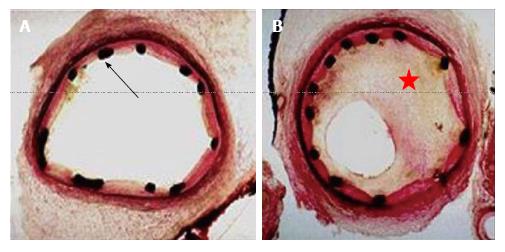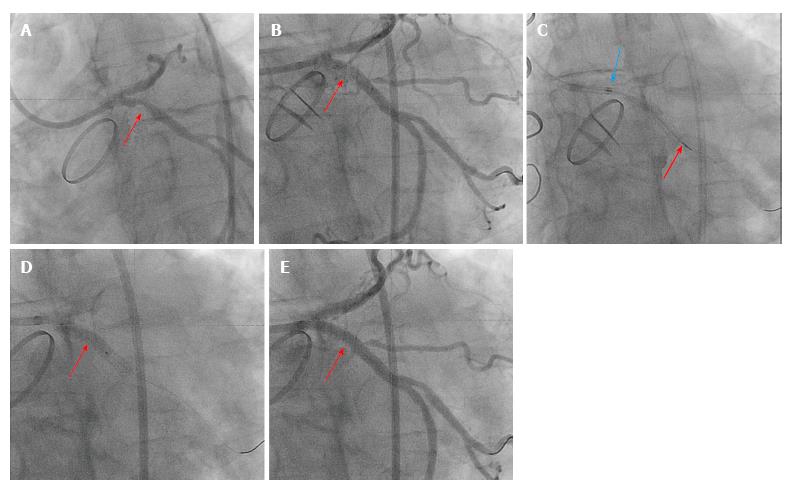Copyright
©The Author(s) 2017.
World J Cardiol. Aug 26, 2017; 9(8): 640-651
Published online Aug 26, 2017. doi: 10.4330/wjc.v9.i8.640
Published online Aug 26, 2017. doi: 10.4330/wjc.v9.i8.640
Figure 1 The figure showing cross-section of coronary artery immediately after implantation of a bare metal stent black dots represent the stent struts (red arrow) (A); the figure showing significant in-stent restenosis with neointimal hyperplasia (red star) 6 mo after the implantation of a bare metal stent (B).
Figure 2 Sixty-seven-year-old man presented with increasing chest pain at rest.
He has past medical history significant for coronary artery disease with PCI and coronary artery bypass grafting. He had PCI with (3.0 mm × 12 mm) DES to LCx, (2.5 mm × 16 mm) DES to RI and (2.5 mm × 16 mm) DES to obtuse marginal a year prior to his presentation. The left internal mammary artery to LAD is patent, however, he is known to have occluded SVG to RI and SVG to first diagonal (D1). Given his increasing chest pain, coronary angiogram was done. A: Coronary stents before contrast injection in LAD (red arrow), LCx (blue arrow); B: Coronary angiogram of the same patient showing severe proximal LCx ISR (blue arrow) with no flow, severe proximal RI ISR (green arrow) with slow flow, and mid LAD severe ISR (red arrow); C: Dilation of the RI coronary artery with 2.5 mm × 22 mm NC balloon with 22 atm inflation pressures was done; D: Coronary angiogram showing the proximal RI ISR (green arrow) post balloon dilation. Red arrow shows severe proximal LAD stenosis with poor flow. LCx has completely occluded ISR (blue arrow); E: The left circumflex ISR lesion (red arrow) was wired and with balloon dilation the flow was restored in the LCx (green arrow); F: IVUS imaging of the underexpanded stent in the proximal LCx lesion. Left panel shows stent struts (red arrow) with evidence of neointimal hyperplasia (yellow star). The right panel shows small stent CSA of only 3.6 mm2 which is below the target 5 mm2 in asians and 6 mm2 in non-asians; G: IVUS imaging of the underexpanded stent in the proximal ramus coronary artery. Left panel shows severely under-expanded stent (red arrow) with evidence of neointimal hyperplasia (yellow star). The right panel shows small stent CSA of only 2.9 mm2; H: Excimer Laser Coronary Angioplasty treatment of LCx (left panl - red arow) and ramus artery (right panel - green arrow) using 0.9 mm coronary laser and the heparinized flush technique. Laser catheter was advanced slowly at 0.2-0.5 m/s during laser emission with careful monitoring of heart rate and blood pressure. Vessel injury such as perforation, dissections and acute closure are the main side effects; I: Post laser balloon dilation with (3.5 mm × 20 mm) NC balloon of both LCx (red arrow) and ramus (green arrow) arteries; J: Sequential kissing stenting technique in the proximal LCx and ramus arties with DES 3.5 mm x 18 mm in Ramus and 3.5 mm × 15 mm in LCx; K: IVUS imaging of the stent in the proximal LCx coronary artery that shows good expansion of the stent with great increase in CSA to 5.9 mm2; L: IVUS imaging of the stent in the proximal ramus coronary artery that shows good expansion of the stent with great increase in CSA to 5.6 mm2; M: TIMI III flow was achieved in the LCx and Ramus coronary arteries without any compromise of LAD. PCI: Percutaneous coronary intervention; DES: Drug-eluting stents; LCx: Left circumflex; RI: Ramus intermedius; LAD: Left anterior descending artery; SVG: Saphenous vein graft; ISR: In-stent restenosis; NC: Non-compliant; IVUS: Intravascular ultrasound; CSA: Cross-sectional area.
Figure 3 Fifty-five-years-old caucasian male with mantle cell radiation for Hodgkin's lymphoma complicated with radiation heart valve disease with severe aortic valve stenosis status post mehanical aortic valve replacement surgery.
Few years later he presented with chest pain and had PCI to the proximal LAD and LCx with DES. However, both few months later he developed ISR and underwent another PCI with DES to the proximal LAD and LCx. Patient was referred for vascular brachytherapy for the treatment of ISR of the LCx due to increased chest pain at rest and recurrent ISR of proximal LCx. A: Coronary angiogram showing 90% focal proximal LCx ISR (red arrow); B: Balloon angioplasty of the proximal LCx lesion (red arrow) to prepare the lesion before brachytherapy delivery; C: Coronary angiogram showing the Novoste Beta-Cath™ System that was used to deliver a source train that contains 12 individual radioactive seeds blue arrow to red arrow). Once properly positioned, 23 Gy from the center of the source center was prescribed. The patient was monitored during the dwell time which required 4 min and 49 s; D: Another balloon angioplasty was done after the radioactive seeds are pulled from LCx; E: Final TIMI-III flow in the LCx. PCI: Percutaneous coronary intervention; LAD: Left anterior descending artery; LCx: Left circumflex; DES: Drug-eluting stents; ISR: In-stent restenosis.
- Citation: Alraies MC, Darmoch F, Tummala R, Waksman R. Diagnosis and management challenges of in-stent restenosis in coronary arteries. World J Cardiol 2017; 9(8): 640-651
- URL: https://www.wjgnet.com/1949-8462/full/v9/i8/640.htm
- DOI: https://dx.doi.org/10.4330/wjc.v9.i8.640











